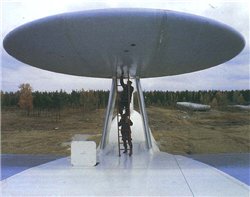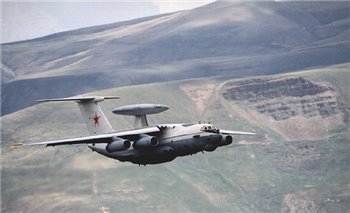Air "Hold"

In connection with the article about Daryal, it is simply impossible not to mention another station of the radar patrol, but already airborne, the so-called. "Oplot" - project A-50.
At one time, the project turned out to be at the forefront of the development of airborne radar and systems, and even now surpasses foreign analogues in some technical characteristics, in particular, the famous American AWACS .
A bit of history
By the beginning of the 70s, the Tu-126 aircraft with radar patrol and targeting ( RLDN ) aircraft with the Liana radar complex, which was in service with the Air Defense Forces, no longer met modern requirements and was significantly inferior to the latest American DRLO E-3A aircraft in terms of its characteristics. By this time, anti-aircraft missile systems literally “pinned” attack aircraft to the ground, where the “Liana” was powerless. A new complex was needed that could track air targets at extremely low altitudes against the background of the earth.
')
In 1969, a government decision was made to begin the development of a radio-technical complex (RTC), which was to detect and accompany high-speed low-profile aerial targets flying off the ground. Its creation engaged the Moscow Research Institute of Instrument Engineering (the head institute of the NGO Vega-M). In addition, one of the requirements of the customer was the use of one of the serial heavy aircraft as a carrier of the new complex. For this reason, the Tupolev design bureau Tu-156 was rejected, according to the general layout, close to the US E-ZA. The new aircraft was made on the basis of the IL-76.

Although, according to the flight characteristics, such a machine lost the carrier version on the basis of a passenger aircraft, the use of a proven and reliable IL-76 serial significantly reduced the cost of the program for creating an RLDN aircraft complex and, in addition, simplified logistics issues during line units. By a decree of the Central Committee of the CPSU and USSR Council of 1973, the creation of an ARLD-A-50 aircraft was prescribed by the OKB under the direction of AK Konstantinov.
First flight
When creating aircraft a large amount of work was done on debugging and fine-tuning the radio engineering complex. At the same time, at the experimental production bureau in Taganrog, in a tense and not always rhythmic mode, the serial IL-76 was converted into the first experimental A-50, which ended in 1978 with the transfer of the aircraft to the tests.
The first flight of the A-50 was made on December 19, 1978, still without the RTC on board (commander - test pilot VP Demianovsky). Later, the aircraft was upgraded with regular RTK and from August 16, 1979, joint state tests began. Since only a small part of electronic equipment was tested at the flying laboratory, in the first test period, the A-50 actually became a bench for ground testing of the radio-technical complex, the reliability of which left much to be desired at first.
Aircraft
The aircraft is made according to the normal aerodynamic scheme with a high-position swept wing and a T-shaped swept tail. The aircraft is equipped with an in-flight refueling system using the hose-cone method.

Above the fuselage on the support is a radome of the onboard radar with a diameter of 10.2 m and a height of 2 m. The support is equipped with an anti-icing system. The aircraft’s avionics provide combat missions with organized interference and opposition from the enemy ... According to the chief designer of the Bumblebee complex, V. P. Ivanov, yielding to the American E-3 Sentry in the target detection range and in the number of automated guidance channels, the A-50 exceeds its level of selection of goals against the background of interfering reflections from the earth's surface. The equipment installed on the A-50 is heavier than American equipment of a similar purpose, approximately one and a half times.

There is a self-defense complex that provides protection against enemy fighters in the front and rear hemisphere, including active and passive electronic countermeasures (and radar reflectors and mounted batteries with false thermal targets - this aircraft was first shown on August 11-16, 1992 at Mosaeros-92) .
LTH
| Modification | A-50 |
| Wingspan, m | 50.50 |
| Aircraft length, m | 46.59 |
| Airplane height, m | 14.80 |
| Maximum diameter of the fuselage, m | 4.80 |
| Wing area, m2 | 300.0 |
| empty aircraft | |
| normal takeoff | 190000 |
| engine's type | 4 TRD PS-90A |
| Thrust, kgf | 4 x 16,000 |
| Max. cruising speed, km / h | 800 |
| Practical range, km | 7500 |
| Practical ceiling, m | 12,000 |
| Crew | 5 + 10 RTK |
Complex tracking
The main “weapon” of our A-50 is the powerful Bumblebee radio-technical complex. The total mass of the radio-technical complex is 20 tons. A radar station operating in the centimeter range is capable of detecting a fighter-class target flying at low altitude against the background of the earth at a distance of 200-400 km, at a high altitude - 300-600 km. Marine targets are detected at a distance of 400 km. The number of simultaneously accompanied targets - 50-60 (on the improved version - up to 150 targets), the number of simultaneously induced fighters - 10-12. To identify the launch of tactical and operational tactical ballistic missiles, as well as sea-based missiles, an infrared missile engine torch detection system can be installed on the upgraded aircraft, capable of detecting a missile launching torch at a distance of 10,000 meters at a distance of 10,000 meters at a distance of up to 1000 km.

The digital computing complex was built using the BTsVMA-50 (Scientific Research Institute “Argon”) with the architecture of an EU-computer. The on-board computer will display the processed information on the screen of the indicators in alphanumeric and planned views. It also lists data on fighters interacting with AKRDN - numbers, course, altitude, speed, fuel balance.
Interaction with interceptors is carried out through fixed automated guidance channels. The range of operational radio communication via the KB channel of the 2000 km range, and via the VHF channel and through the broadband radio link - 400 km. There is a satellite radio link providing global connectivity. The aircraft is equipped with a flight-navigation system designed for solving aircraft support tasks in any meteorological conditions, at any geographic latitudes, at any time of the day, as well as for issuing flight-navigation information to special complexes.
So, the aviation complex A-50 can:
- detect and track aerial targets
- identify their nationality
- to control air traffic and aiming
- transmit radar data in the survey zone to other air defense participants
- take commands from the control point
- perform command control functions
- identify sources of radiation and bearing on them
Combat duty
In December 1984, according to the results of the tests, it was decided to build serial A-50s at the Tashkent Aviation Plant. In 1985, the pilot operation of aircraft in the front-line units began, which lasted until 1988.

In the West, the new Soviet aircraft RLDN was given the codename " Mainstay " - a stronghold. For the first time, “probable opponents” saw him near December 4, 1987, when the Norwegian anti-submarine R-3B “Orion” from the 333rd Squadron discovered A-50 above the neutral waters of the Barents Sea.
Officially, the complex was adopted in 1989. For its creation, a Government Decree of January 16, 1996 gave the State Prize of the Russian Federation in the field of science and technology to a group of leading specialists in the aviation and radio engineering industry and the Air Force. Among the laureates are the creators of the A-50: A.K. Konstantinov, G.S. Panatov and S.A. Atayants.
Until 1990, the A-50 aircraft carried out routine service, from time to time participating in large-scale exercises, both of the USSR Armed Forces, and jointly with the armies of the Warsaw Pact organization members. In the winter of 1991, during the fighting in the Persian Gulf, a pair of A-50s patrolled over the waters of the Black Sea, monitored combat planes of the anti-Iraq coalition, which launched strikes against Iraq from Turkey. At the same time, the regiment had to leave the lived-in base, suddenly found itself in "sovereign" Lithuania and fly over to the northern Russian airfield of Pechora. Now all Russian A-50s are part of an aviation base for the combat use of XRDN aircraft based at the Ivanovo airfield.

The A-50 got to its first “real” war only at the end of 1994, however, when it was created, no one and in a nightmare could dream that it would happen on their land, in Chechnya. Three A-50 aircraft were transferred to Privolzhsky operational airfield. After December 21, 1994, after almost a three-year break, the Russian air defense regained full control over Chechnya’s airspace, the A-50 planes, which were constantly in the air, created a continuous radar field over the combat zone. Joint patrols of the A-50 and Su-27 and MiG-31 interceptors did not allow Chechen separatists to organize an “air bridge” with foreign countries. The A-50 aircraft performed similar tasks during the antiterrorist operation in the winter of 1999-2000.
Present and future
In 1988, one A-50 was converted into an A-50E for possible export sales. In this variant, he was demonstrated in 1988, in Kubinka, to Admiral Nadkarni, chairman of the joint committee of the chiefs of staff of India.
One of the production aircraft in 1997-1999. It was converted to the TANTK them. G. Beriev in the version of the AI for the installation of the Israeli radio-electronic complex.
In April 2000, one A-50 was taken by the Indian Air Force in a short-term lease from the Russian Air Force. A total of ten flights were performed, each lasting up to 6 hours. The car was piloted by a Russian crew from the aviation base of the combat use of the XRDS aircraft, which also owned the machine, but Indian specialists also took part in the flights. Based on the A-50 at the airport Chandihang (Punjab).
At present, the relevance of the further development of the RLDN aviation complexes has increased even more, and the A-50 is the only aircraft of this class as part of the Russian Air Force. Aircraft XRDN are indispensable participants in all ongoing tactical flight exercises of the Russian Air Force. The A-50E variant is being created for export deliveries.
Material prepared by:
Source: https://habr.com/ru/post/87320/
All Articles